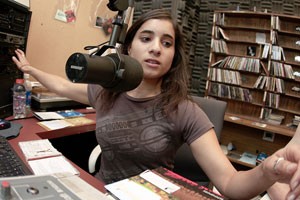Students will vote not only on their government representatives today, but also whether or not they want to pay $1 a year to keep their on-campus radio station.
Over the past few weeks, KAMP Student Radio has been out on the UA Mall almost every day passing out flyers, doing public service announcements for the station and speaking in front of groups like the Residence Hall Association, said Karl Goranowski, KAMP Student Radio’s general manager.
KAMP Student Radio is a student-run radio station broadcasting on AM 1570 and live on its Web site. It also has music shows on the mall and provides a mobile DJ service.
“”We couldn’t have the studio space or many of the opportunities we have now without the dollar fee,”” Goranowski said.
Mike Camarillo, KAMP Student Radio’s broadcast advisor, said the fee would continue to support the program as it is and allow it to grow as technology grows.
If the fee doesn’t pass, KAMP would be forced to resort back to what it was 10 years ago before the dollar fee was passed, he said.
“”We were just a club on campus, same sort of amount of funding as any other club,”” Goranowski said.
Losing the extra funding from the student fee could result in not being able to pay the debt for its studio to Arizona Student Unions, which would force it to move out, Goranowski said.
KAMP Student Radio started out 20 years ago as the Student Union Radio Task Force, and has existed in its current form as a member of Arizona Student Media for the past 10 years after the $1 fee was first passed, Goranowski said.
The $1 fee first went into effect in 1998 and was passed again in 2003. KAMP is looking to approve it for the third time today.
The first fee was created due to a grassroots effort from the students and has passed overwhelmingly ever since, said Mark Woodhams, director of Arizona Student Media, an umbrella group of KAMP.
“”Its always had a lot of support,”” Woodhams said.
“”Campus radio opens up tremendous opportunities for any student that wants to be involved,”” Goranowski said. “”Anyone can get involved in KAMP and find a niche and really enjoy themselves.””
“”It’s a training ground for so many skills and opportunities for students,”” Woodhams said. He said there are more than 300 students in Arizona Student Media, which includes KAMP, UATV-3, the Arizona Daily Wildcat and RedBlue magazine.
“”You can’t get that experience anywhere else on campus,”” Woodhams said.
Goranowski said more than 40 former KAMP students have pursued careers in media and the music industry.
“”It’s a great stepping stone, it’s a great tool for people to learn, and it’s also a lot of fun,”” Goranowski said.
Because the KAMP Student Radio signal only reaches to areas on campus and is broadcast on channel 20 in the dorms, the station loses some listeners once they are out of the dorms, Camarillo said.
“”I think the last time I listened was in the dorms freshman year,”” said Liem Le, a math education senior.
He said he didn’t mind the fee if it helped somebody else’s experience.
“”I guess it’s kind of a cool platform to people trying to get into that industry,”” Le said.
“”I don’t listen to it,”” said Krystalyn Kinsel, a political science senior. “”But it’s only a dollar.””
Goranowski said he is “”pretty confident”” the fee will pass again because of the student feedback he’s gotten, but still stresses the need for more support.
“”College radio is a thing every college should have and every college student should experience,”” Goranowski said.
“”The real thrill of KAMP is in the music,”” Woodhams said. “”It’s the one place where new artists, off-beat artists and alternative artists can be heard.””
“”If people take a minute to appreciate what’s out there, I think they’ll really enjoy what’s there,”” Camarillo said. “”It’s college radio – the artists that are out there, they probably would never be heard except on true college radio.””









